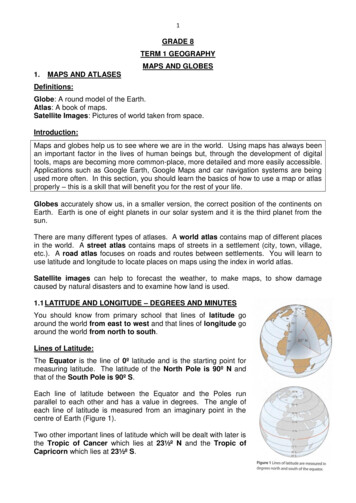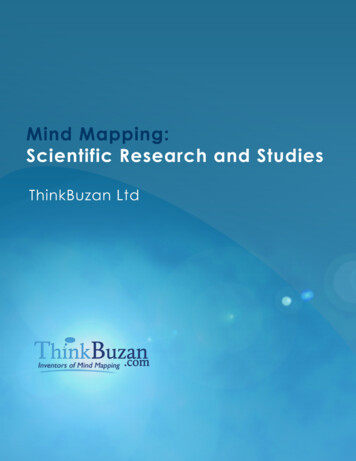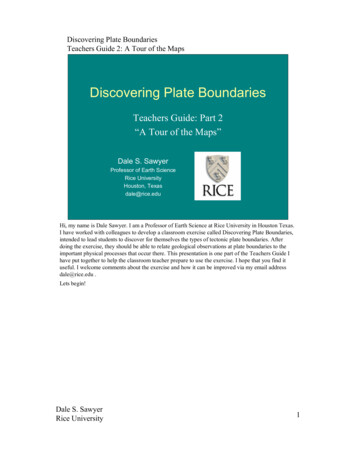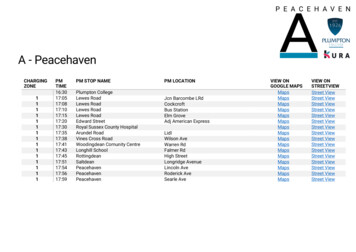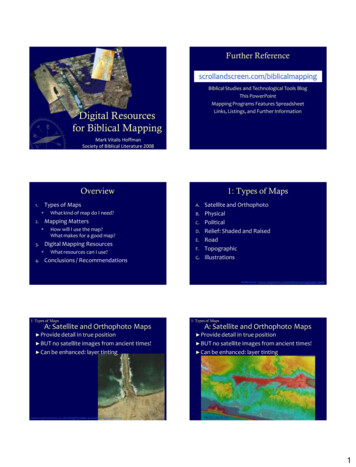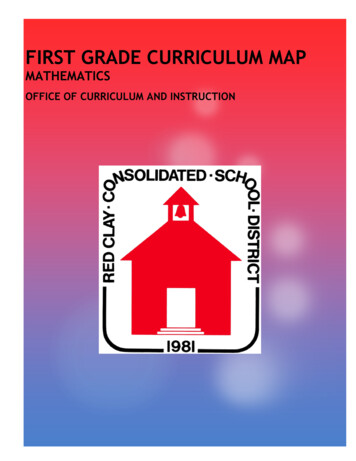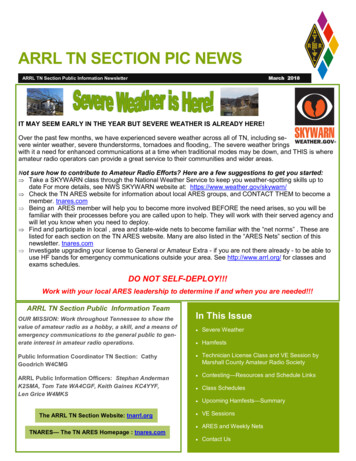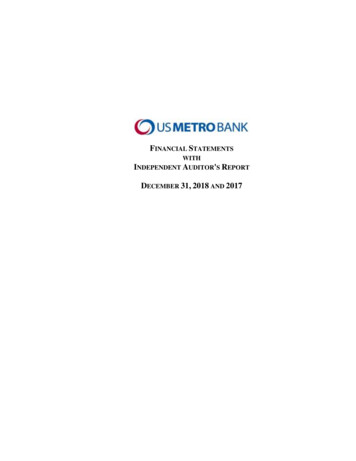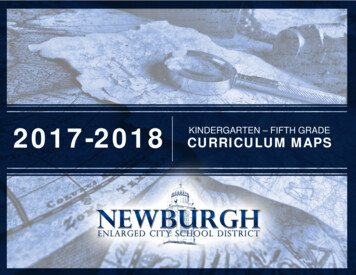
Transcription
2017-2018KINDERGARTEN – FIFTH GRADECURRICULUM MAPS
Newburgh Enlarged City School District2017-2018 K-5 Curriculum Maps IntroductionWelcome to the Newburgh Enlarged City School District 2017 - 2018 K-5 curriculum maps. It is the desire of the District to provide a well-articulated and highquality curriculum that supports teachers and administrators on behalf of our students.Curriculum is fluid; it changes periodically throughout the year and over time as we reflect, evaluate and revise it based upon observed student data andstudent needs. Our curriculum targets state and national standards. That said, teachers are expected to differentiate the curriculum and adjust it, as necessary, fortheir students. The individual education plans for students with disabilities may also require modification to curriculum, which is not indicated on the maps. Pleasenote that every effort is made to keep the details of the maps current. However, curriculum mapping is an ongoing process which works best when done in teams.Please read the maps as an outline of skills, knowledge and understandings. The maps are not intended to be lesson plan documents.This document bundles together a variety of resources. It begins with the introduction, then a year at a glance for each grade level, and a readingfoundational skills map for grades K-2. Classroom planning and instruction based on the standards should develop within the context of the practices set forth byeach content area (ELA, Math, Social Studies, and Science). By design these maps support the Literacy Framework and the instructional practices outlined within.This document will reflect the most current NYS Next Generation standards in ELA, Math, and Science and the NYS Social Studies Framework. The district expectsstudents to “think, write, speak, and listen to understand” every day, in all subject areas. These practices should be the foundation of all planning and design.The practices also indicate that teachers should expect students to read often and widely from a range of global and diverse texts Teachers shouldencourage students to explore a wide range of texts, including a balance of classical and contemporary literature. Students should also read fulllength and shorter texts from a variety of cultures and viewpoints, both in print and digital media.”(NYS Education Department 2017)NYS ELA Lifelong Practices of Readers and WritersLifelong Practices of ReadersReaders think, write, speak, and listen to understand. read often and widely from a range of global and diverse textsillustrating a variety of viewpoints. read for multiple purposes, including for learning and forpleasure. self-select texts based on interest.Lifelong Practices of WritersWriters think, read, speak, and listen to support writing. write often and widely in a variety of formats, using print and digitalresources and tools. write for multiple purposes, including for learning and for pleasure. persevere through challenging writing tasks.
persevere through challenging, complex texts enrich personallanguage, background knowledge, and vocabulary throughreading and communicating with others.monitor comprehension and apply reading strategies flexibly.make connections (to self, other texts, ideas, cultures, eras, etc.). enrich personal language, background knowledge, and vocabularythrough writing and communicating with others.experiment and play with language.analyze mentor texts to enhance writing strengthen writing byplanning, revising, editing, rewriting, or trying a new approach.NYS Core Content Area PracticesNYS Mathematical Practices1. Make sense of problems and persevere insolving them2. Reason abstractly and quantitatively3. Construct viable arguments and critique thereasoning of others4. Model with mathematics5. Use appropriate tools strategically6. Attend to precision.7. Look for and make use of structure8. Look for and express regularity in repeatedreasoningNYS Social Studies Practices1. Gathering, Interpreting and UsingEvidence2. Chronological Reasoning and Causation3. Comparison and Contextualization4. Geographic Reasoning5. Economics and Economic Systems6. Civic ParticipationNYS Science Practices1. Asking questions (for science) anddefining problems (for engineering)2. Developing and using models3. Planning and carrying out investigationsAnalyzing and interpreting data4. Using mathematics and computationalthinking5. Constructing explanations (for science)and designing solutions (for engineering)6. Engaging in argument from evidence7. Obtaining, evaluating, andcommunicating information
Reading Foundational Skills K-5English & 2.AKindergarten1st GradeDemonstrate understanding ofthe organization and basicfeatures of print.Follow words from left toright, top to bottom, and pageby page.Demonstrate understanding ofthe organization and basicfeatures of print.Recognize the distinguishingfeatures of a sentence (e.g.,first word, capitalization,ending punctuation).Recognize that spoken wordsare represented in writtenlanguage by specificsequences of letters.Understand that words areseparated by spaces in print.Recognize and name allupper- and lowercase letters ofthe alphabet.Demonstrate understanding ofspoken words, syllables, andsounds (phonemes).Recognize and producerhyming words.Demonstrate understanding ofspoken words, syllables, andsounds (phonemes).Distinguish long from shortvowel sounds in spokensingle-syllable words.RF.2.BCount, pronounce, blend, andsegment syllables in spokenwords.Orally produce single-syllablewords by blending sounds(phonemes), includingconsonant blends.RF.2.CBlend and segment onsets andrhymes of single-syllablespoken words.Isolate and pronounce initial,medial vowel, and finalsounds (phonemes) in spokensingle-syllable words.2nd Grade3rd Grade4th Grade5th Grade
Reading Foundational Skills K-5English & SpanishStandardKindergarten1st GradeIsolate and pronounce theinitial, medial vowel, and finalsounds (phonemes) in threephoneme (consonant-vowelconsonant, or CVC) words.Add or substitute individualsounds (phonemes) in simple,one-syllable words to makenew words.Know and apply grade-levelphonics and word analysisskills in decoding words.Isolate and pronounce theinitial, medial vowel, and finalsounds (phonemes) in threephoneme (consonant-vowelconsonant, or CVC) words.RF.3.ARF.3.BRF.2.DRF.2.ERF.3RF.3.C2nd Grade3rd Grade4th GradeKnow and apply grade-levelphonics and word analysisskills in decoding words.Know and apply gradelevel phonics and wordanalysis skills indecoding words.Demonstrate basic knowledgeof one-to-one letter-soundcorrespondences by producingthe primary sound or many ofthe most frequent sounds foreach consonant.Know the spelling-soundcorrespondences for commonconsonant digraphs.Distinguish long andshort vowels whenreading regularlyspelled one-syllablewords.Know and applygrade-level phonicsand word analysisskills in decodingwords.Identify and know themeaning of the mostcommon prefixes andderivational suffixes.Know and applygrade-level phonicsand word analysisskills in decodingwords.Use combinedknowledge of allletter-soundcorrespondences,syllabication patterns,and morphology (e.g.,roots and affixes) toread accuratelyunfamiliarmultisyllabic words incontext and out ofcontext.Associate the long and shortsounds with the commonspellings (graphemes) for thefive major vowels.Read common high-frequencywords by sight (e.g., the, of,to, you, she, my, is, are, do,does).Decode regularly spelled onesyllable words.Know spelling-soundcorrespondences foradditional commonvowel teams.Decode regularlyspelled two-syllablewords with longvowels.Know final -e and commonvowel team conventions forrepresenting long vowelsounds.Decode words withcommon Latinsuffixes.Decode multi-syllablewords.5th GradeKnow and apply gradelevel phonics and wordanalysis skills indecoding words.Use combinedknowledge of all lettersound correspondences,syllabication patterns,and morphology (e.g.,roots and affixes) to readaccurately unfamiliarmultisyllabic words incontext and out ofcontext.
Reading Foundational Skills K-5English & SpanishStandardRF.3.DKindergartenDistinguish between similarlyspelled words by identifyingthe sounds of the letters thatdiffer.RF.3.ERF.3.FRF.3.GRF.4Read emergent-reader textswith purpose andunderstanding.1st GradeUse knowledge that everysyllable must have a vowelsound to determine thenumber of syllables in aprinted word.Decode two-syllable wordsfollowing basic patterns bybreaking the words intosyllables.Read words with inflectionalendings.Recognize and read gradeappropriate irregularly spelledwords.Read with sufficient accuracyand fluency to supportcomprehension.RF.4.ARead grade-level text withpurpose and understanding.RF.4.BRead grade-level text orallywith accuracy, appropriaterate, and expression onsuccessive readings.RF.4.CUse context to confirm or selfcorrect word recognition andunderstanding, rereading asnecessary.2nd GradeDecode words withcommon prefixes andsuffixes.3rd Grade4th Grade5th GradeRead with sufficientaccuracy and fluencyto supportcomprehension.Read grade-level textwith purpose andunderstanding.Read grade-level proseand poetry orally withaccuracy, appropriaterate, and expression onsuccessive readings.Use context to confirmor self-correct wordrecognition andunderstanding,rereading as necessary.Read with sufficientaccuracy and fluency tosupport comprehension.Read gradeappropriate irregularlyspelled words.Identify words withinconsistent butcommon spelling-soundcorrespondences.Recognize and readgrade-appropriateirregularly spelledwords.Read with sufficientaccuracy and fluency tosupport comprehension.Read grade-level textwith purpose andunderstanding.Read grade-level textorally with accuracy,appropriate rate, andexpression onsuccessive readings.Use context to confirmor self-correct wordrecognition andunderstanding,rereading as necessary.Read with sufficientaccuracy and fluencyto supportcomprehension.Read grade-level textwith purpose andunderstanding.Read grade-level proseand poetry orally withaccuracy, appropriaterate, and expression onsuccessive readings.Use context to confirmor self-correct wordrecognition andunderstanding,rereading as necessary.Read grade-level textwith purpose andunderstanding.Read grade-level proseand poetry orally withaccuracy, appropriaterate, and expression onsuccessive readings.Use context to confirmor self-correct wordrecognition andunderstanding, rereadingas necessary.
Reading Foundational Skills K-5English & 2.ARF.2.BKindergarten1st GradeDemostrar conocimiento de laorganización y lascaracterísticas básicas de laescritura.Seguir las palabras deizquierda a derecha, de arribahacia abajo y página porpágina.Reconocer que las palabrasdichas verbalmente estánrepresentadas por escrito porsecuencias de letrasespecificas.Comprender que en ellenguaje escrito las palabrasestán separadas por espaciosen blanco.Reconocer y nombrar todas lasletras mayúsculas yminúsculas.Demostrar conocimiento delas palabras, los sonidos y lassílabas.Reconocer y producir palabrasque riman.Contar, pronunciar, juntar yseparar sílabas en palabrasverbalmente.Demostrar conocimiento de laorganización y lascaracterísticas básicas de laescritura.Reconocer las distintas partesde una oración (la primerapalabra, la letra mayúscula, elsigno de puntuación).Demostrar conocimiento delas palabras, los sonidos y lassílabas.Reconocer y leer palabras dedos sílabas.Contar, pronunciar, unir yseparar palabras de dossílabas.2nd Grade3rd Grade4th Grade5th Grade
Reading Foundational Skills K-5English & artenDemostrar conocimiento de lamayoría de las sílabas abiertas(consonante vocal).Ejemplo: ma, me, me, mi, mo,muSeparar, reconocer ypronunciar la letra o sílabainicial en palabras de dossílabas.Añadir o sustituir sílabas enpalabras de dos sílabas paraformar una palabra nueva.Reconocer y aplicar lafonética y analizar las palabrasusando la descodificación.Demostrar conocimientobásico de la correspondenciauno a uno entre letra y sonidode las consonantes y reconocerel primer sonido de laspalabras.1st Grade2nd Grade3rd Grade4th Grade5th GradeReconocer y aplicar lafonética y analizar laspalabras usando ladescodificación.Distinguir lasinflexiones y los sufijosal leer palabras de tressílabas, incluyendo lassílabas cerradas.(Ejemplo: persigues)Reconocer y aplicar lafonética y analizar laspalabras usando ladescodificación.Identificar y saber elsignificado de lamayoría de los prefijosy sufijos. (Ejemplo:mal-, des- dis-, pre-,con-, -ado, -ido, -ando,-iendo )Reconocer y aplicar lafonética y analizar laspalabras usando ladescodificación.Combinar y usar elconocimiento de todaslas estrategias:-la correspondencia deletras y sus sonidos-los patrones de lassílabas (dígrafos,inflexiones, diptongos)-la morfología (raíces,prefijos, sufijos)Reconocer y aplicar lafonética y analizar laspalabras usando ladescodificación.Combinar y usar elconocimiento de todaslas estrategias:-la correspondencia deletras y sus sonidos-los patrones de lassílabas (dígrafos,inflexiones, diptongos)-la morfología (raíces,prefijos, sufijos) para leer palabrascon más de tres sílabascon precisión dentro yfuera del contexto. para leer palabras conmás de tres sílabas conprecisión dentro y fueradel contexto.Demostrar conocimiento dela mayoría de las sílabasabiertas (consonante vocal). Ejemplo: ma, me,me, mi, mo, muSeparar, reconocer ypronunciar las letras o sílabasen palabras de dos sílabas.Reconocer y aplicar lafonética y analizar las palabrasusando la descodificación.Leer palabras de dos sílabascon los dígrafos consonánticoscommunes. (bl, cl, fl, gl, pl, br,cr, dr, fr, gr )
Reading Foundational Skills K-5English & SpanishStandardKindergartenRF.3.BReconocer y producir lascinco vocales.RF.3.CLeer las palabras másfrecuentes a simple vista.Ejemplo: el, ella, la, de, por,mi, mis, un, una, nos, son, es,que, más, veo, puedo).RF.3.DDescodificar palabras de dossílabas separando las palabrasen sílabas.1st GradeDescodificar palabras de dossílabas.2nd GradeReconocer losdiptongos en palabrasde tres sílabas.Ejemplo: (canciones,perseguir)Descodificar palabrasde tres sílabasincluyendo sílabascerradas. (Ejemplo:cantamos – can/ta/mos)Usar el conocimiento de quecada sílaba debe tener unavocal para determinar elnúmero de sílabas en unapalabra escrita.RF.3.EDescodificar palabras de dossílabas abiertas separando laspalabras en sílabas.RF.3.FDescodificar palabras de dossílabas con inflexiones. (–s, -r,-n) (pones, saber, comen) yleer los diptongos comosuenan al hablar (gue, pue)RF.3.GReconocer y leer palabrasapropiadas al grado.Descodificar palabrascon prefijos y sufijos yleer correctamente laspalabras con acentodiacrítico. Ejemplo:esta/ está, papa/ papáDescodificar palabrascon más de tres sílabasseparando las palabrasen sílabas. Ejemplo:(comunicar –co/mu/ni/car)Reconocer y leerpalabras con más detres sílabas apropiadaspara el grado coninflexiones (–s, -r, -n) ydiptongos (juntaremos,endeudado).3rd GradeDescodificar palabrascon más de tres sílabascon prefijos y ar palabrascon más de tressílabas.(Ejemplo: constitución– cons/ti/tu/ción,extremadamente –ex/tre/ma/da/men/te)Leer palabrasapropiadas para elgrado correctamente(incluyendo el acentodiacrítico).4th Grade5th Grade
Reading Foundational Skills K-5English & SpanishStandard1st Grade2nd Grade3rd Grade4th GradeLeer con suficiente precision yfluidez para apoyar lacomprensión.Leer con suficienteprecision y fluidez paraapoyar la comprensión.RF.4.ALeer libros al nivel del gradocon sentido y comprensión.RF.4.BLeer libros al nivel del gradoen voz alta y con fluidez,entonación apropiada yexpresión en lecturassucesivas.Leer libros al nivel delgrado con sentido ycomprensión.Leer libros al nivel delgrado en voz alta y confluidez, entonaciónapropiada y expresiónen lecturas sucesivas.Leer con suficienteprecision y fluidezpara apoyar lacomprensión.Leer libros al nivel delgrado con sentido ycomprensión.Leer libros al nivel delgrado en voz alta ycon fluidez,entonación apropiaday expresión en lecturassucesivas.RF.4.CUsar el contexto paraconfirmar o corregirse a simismo en el reconocimiento yla comprensión de palabras,volviendo a leer cuando seanecesario.Leer con suficienteprecision y fluidezpara apoyar lacomprensión.Leer libros al nivel delgrado con sentido ycomprensión.Leer poesías y prosasapropiadas para elnivel del grado en vozalta y con fluidez,entonación apropiaday expresión en lecturassucesivas.Usar el contexto paraconfirmar o corregirsea si mismo en elreconocimiento y lacomprensión depalabras, volviendo aleer cuando seanecesario.RF.4KindergartenLeer libros para lectoresemergentes con sentido ycomprensión.Usar el contexto paraconfirmar o corregirse asi mismo en elreconocimiento y lacomprensión depalabras, volviendo aleer cuando seanecesario.Usar el contexto paraconfirmar o corregirsea si mismo en elreconocimiento y lacomprensión depalabras, volviendo aleer cuando seanecesario.5th GradeLeer con suficienteprecision y fluidez paraapoyar la comprensión.Leer libros al nivel delgrado con sentido ycomprensión.Leer poesías y prosasapropiadas para el niveldel grado en voz alta ycon fluidez, entonaciónapropiada y expresión enlecturas sucesivas.Usar el contexto paraconfirmar o corregirse asi mismo en elreconocimiento y lacomprensión depalabras, volviendo aleer cuando seanecesario.
K- 2 Foundational Skills Curriculum MapThis map provides teachers with a continuum that identifies a series of complex skills that build toward proficiency. All students do not develop their understandings atthe same rate. It is important that teachers have a full picture of these understandings in order to support students.It is important to recognize that the reading and writing foundational skills are not the only goal of literacy. The significance lies in how the student applies these skillsin reading and writing continuous text. The more students can process language fluently and rapidly, the more likely they will read and write with ease.The K-2 maps are set up by nine areas of learning that represent a comprehensive picture of the foundational skills students need. Each map includes the essentiallearning, along with language that will be helpful to the teaching. It is important that the language used is consistent and clear. In addition, the maps include the NYSstandards addressed along with the resources available to teach the skill(s).Early LiteracyConceptsPhonologicalAwarenessLetter KnowledgeLetter-SoundRelationshipsSpelling PatternsHigh FrequencyWordsWord MeaningVocabularyWord StructureWord SolvingNine Areas of Learning (Fountas & Pinnell 2017)Includes the understanding of concepts of print such as reading left to right, front and back of book, and one to one matching. Learnerswho enter Kindergarten not knowing these skills need to have direct explicit instruction in this area.The ability to hear and recognize sounds in words allows the learner to connect it to letters and words. Learners who can recognizesound in words also need to be able to identify, isolate and manipulate the soundsThis refers to how the letters look. Learners need to learn the names, distinguishing features, how to use them in words, and how to findthem in text.Learners need to learn the connections between letters and sounds in order to understand basic written language. Oral language needs tobe developed and is basic to understanding the written language.Readers and writers look for and find patterns in words. Knowing these spelling patterns helps learners in word solving and writingwords quickly.A core of high frequency words help to build reading and writing processes. Recognizing these words automatically allows the reader topay more attention to the meaning or solving new words in continuous text. Explicit instruction of these words in continuous text aid indeveloping automaticity and help readers to look at the features of words.For understanding and consistency in reading and writing, students need to know the meaning of words. In order to expand vocabularieslearners must be engaged in complex text in order to build listening, speaking, reading and writing vocabularies.Words are built according to rules. Learners need to learn how words are related to each other and how they can be changed. Thisincludes breaking down words and categorizing word parts.This includes strategic moves readers and writers use when they use their knowledge of language while reading and writing continuoustext. These should all be “in the head” actions.adapted from: Fountas & Pinnell (2017). The comprehensive phonics, spelling, and word study guide. Heinemann, NH.
Phonics Lesson Framework:These maps do advocate for explicit phonics and word study lessons (see lesson framework below) with an element of inquiry; however, it is essential for students tolearn how words work through reading and writing continuous text all the time. TEACHWhole-class lessons based on a principle related to phonics. The inclusion of inquiry, where possible, allows students to discover something about languageand makes the lesson enjoyable. Students become pattern seekers and word discoverers, which, hopefully, will be a lifelong habit. APPLYThrough hands-on practice to apply the principle. Students can learn much more through hands-on activities because they provide an experience inconstructing their own knowledge. Hands on activities can be found in the iREAD resources. You can choose to have all the children do the activitysimultaneously, individually, or with a partner after the lesson. If you choose you could put in as a word study center as they develop the ability to manage theirown learning. SHAREStudents meet briefly in a whole-class meeting, to talk about the discoveries they made. This brief sharing time gives you a chance to assess the effectivenessof your lesson, return to the principle and summarize the learning, and link to reading and writing so students know how to use what they have learned.Other Phonics Resources:Alphabet Linking Chart: It is a tool for supporting children's learning of letter names in uppercase and lowercase forms, the related sounds,and letter formation. We refer to it in many lessons and have built it together in a meaningful way.How To: You could read the whole chart, read just the pictures, read just the letters, read just the uppercase letters, read just the lowercaseletters, read the consonants, read the 2 sounds for each vowel (the hard/long or soft/short), sing the chart to the tune of the alphabet song, readevery other letter, read randomly as you point to boxesConsonant Cluster Linking Chart: This chart includes pictures that begin with two consonant letters, including consonant digraphs. It is atool which is designed to help children develop quick recognition and blending of initial consonant clusters and digraphs.How To: Read it in order (e.g., /bl/ blanket, /b/r bridge), read randomly as you point to boxes, read every other box, read it backwards, havethem find a word in a text/book that starts with that cluster.
Grade K – Year at a GlancePlease see each unit’s scope and sequence for more detailed berDecemberJanuary-FebMarch-AprilMay-JuneWhat Makes Me Special andUniqueHow I Can Be a GoodCitizenAmericanUnderstanding theWorld We Live InWeatherPlants and TheirEnvironmentLaunching the Writers’ Workshop(Book 1)Closely: Observing,Labeling, and Listing LikeScientists (If.Then )Writing All-About Books(If.Then .)Persuasive Writing ofAll Kinds (Book 4)Readers areResourceful: TacklingHard Words and TrickyParts in BooksReaders Get to KnowCharactersUse a combination of drawing,dictating, and writing to composeinformative/explanatory texts inwhich they name what they arewriting about and supply someinformation about the topic.Readers Read, Think, andTalk about Emergent StoryBooks and Familiar SharedTextsWriting for Readers (Book 2)Readers Use Superpowers toRead Everything in theClassroom and BeyondLearning AboutOurselves and OurWorld: Reading forInformationCounting and Cardinality: Writenumbers from 0 to 20.Operations and AlgebraicThinking: Number Pairs,Addition and Subtractionto 10Geometry: Two Dimensionaland Three Dimensional ShapesNumbers andOperations in Base Ten:Numbers 10 – 20; Countto 100 by Ones andTensMeasurement andData: Comparison ofLength, Weight,Capacity and Numbersto 10Geometry: Analyzing,Comparing andComposing shapesWhat makes me UniqueStudents learn how a person’ssense of self is shaped byexperiences that are unique tothem and their families, and bycommon experiences shared by acommunity or nation.Cultural IdentityStudents learn aboutindividual develop andcultural identity, civicideals and practices, andgeography, humans, andthe environment.AmericanStudents compare waysdiverse cultural groups withthe community celebrateholidaysEconomicStudents learn abouthow people haveeconomic needs andwants, and how goodsand services can satisfypeople’s wants.Students learn howmaps and globesrepresent Earth’ssurface and are used tolocate and betterunderstand places andregions.Communities past,present, futureStudents learn howpeople andcommunities areaffected by and adapt totheir physicalenvironment.Geography, Humans,and the EnvironmentStudents comparedifferentenvironments andthe plants andanimals that livethereMathSocial StudiesHow-To Books: Writingto Teach Others(Book 3)Each person is unique but alsoshares common characteristicswith other families, peers, andcommunity members.The past, present andfuture describe points intime and help usexamine andunderstand events.
ScienceCulminatingAssessment(s)Matter and Its Interactions:Children learn how matter exist aseither solid or liquid, depending ontemperature.Matter and ItsInteractions:Students ask questionsand use observations totest the claim thatdifferent kinds of matterexist as either solid orliquid.Forces and Interactions:Pushes and PullsForces and Interactions:Pushes and PullsWeather and Climate:Use and shareobservations of localweather conditions todescribe patterns overtime.InterdependentRelationships inEcosystems:Animals, Plants, andTheir EnvironmentChildren will select a few stories topublish and will learn to revise andedit as they make those stories thebest they can be.Students will demonstratethe targetedunderstandings throughone of the followingmethods:Students learn the process oftaking a single piece of writingto publishing. Students willspend time both editing andrevising and will work oncreating an ending thatintroduces a big feeling.Since this unit focuses onwriting for readers, you willwant to invite an audience tocome read your students’stories. This could be anotherkindergarten class, a buddyclass, or other staff membersfrom the building. Beforehosting the celebration, askstudents to look at theirwriting and identify one ormore things they learned (andis evident) in their writing. Thiscan be written on a post-itnote and adding to their piece.Encourage visitors to also addcomments to the studentswriting. Display the writingand all of the comments onAuthor’s board in theclassroom or hall.Students willdemonstrate thetargetedunderstandings throughone of the followingmethods:Students willdemonstrate thetargetedunderstandings throughone of the followingmethods:Sort images of needsand wants.Write an "All About."Book/poster usinginformation learnedfrom text.Students willdemonstrate thetargetedunderstandingsthrough one of thefollowing methods:Write anadvertisement tryingto persuade thereader to try a newproduct.The task will show that studentsunderstand that every person isunique and special; families can besimilar and different, but we allcelebrate special times, andrespect and caring are necessaryfor every community to which webelong.Choose from the followingPerformance Tasks or projects: Create a book Create a poster Create a graphicorganizer Create a graph List qualities of a caringclassroom/school Create a quilt (paper)Create a list of class rules.Create a class book.Draw visualimages/writing captionsfor images.Complete a project on theAmerican Flag and/orCompare the AmericanFlag to those of othernations.Students will revise theirwriting to make it the bestit can be and fancy it upfor the publishingcelebrationStudents will transfer andapply their knowledge ofletters and sounds tolabeling items and listingobservations.Create a page for a classbook.Visit school communityworkers to observetheir tools.Interview schoolcommunity workers.Use a favorite book towrite about what waslearned.Create a poster or bookto represent newunderstandings gainedfrom a favoriteinformational text.Teach about a topic.Conduct a Share Fair.Invite an older class totour the classroom asthe kindergarteners stayat “posts” around theroom ready to teach thevisitors about theirtopics. Students canwear signs around theirnecks that say, “Ask meabout cats,” or “Ask meabout bikes.”Write a persuasiveletter to a character.Write a persuasiveposter or letter tosave theenvironment.
Reading Foundational Skills K-5KINDERGARTENStandard K.3.ARF.K.3.BRF.K.3.CRF.K.3.DRF.K.4Demonstrate understanding of the organization and basic features of print.SpanishDemostrar conocimiento de la organización y las característicasbásicas de la escritura.Follow words from left to right, top to bottom, and page by page.Seguir las palabras de izquierda a derecha, de arriba hacia abajo ypágina por página.Recognize that spoken words are represented in written language by specificReconocer que las palabras dichas verbalmente están representadassequences of letters.por escrito por secuencias de letras especificas.Understand that words are separated by spaces in print.Comprender que en el lenguaje e
each content area (ELA, Math, Social Studies, and Science). By design these maps support the Literacy Framework and the instructional practices outlined within. This document will reflect the most current NYS Next Generation standards in ELA, Math, and Science and the NYS Social Studies Framework. The district expect s
